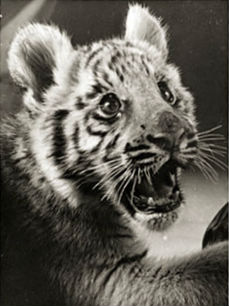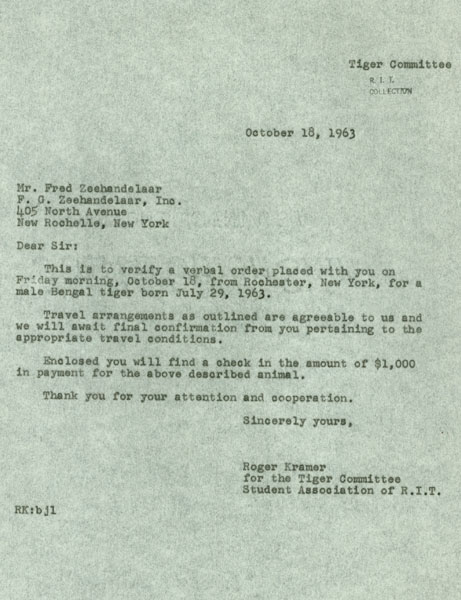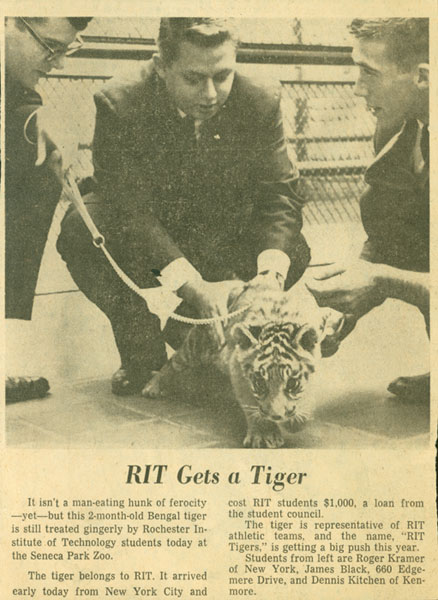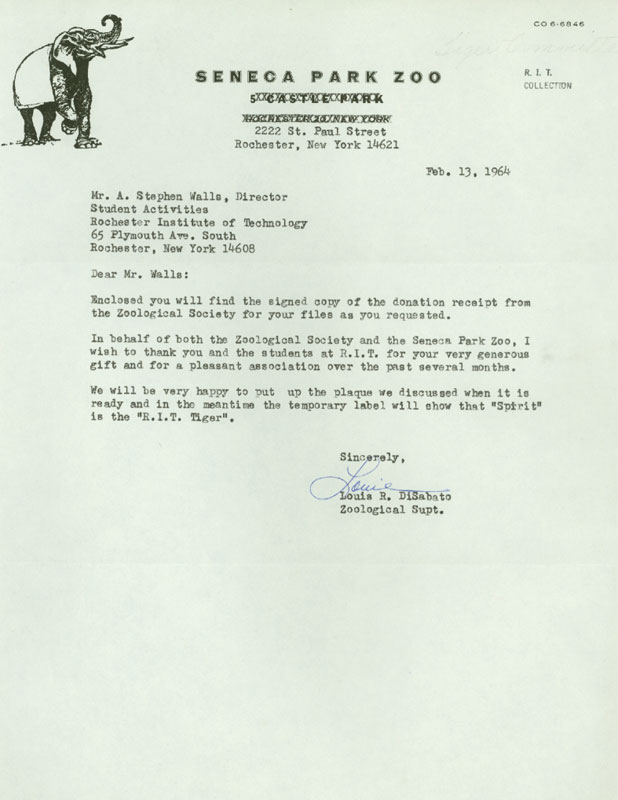The Story
Part 1

In 1963-1964, a Bengal tiger prowled the halls of RIT. In his short life, that cat had a profound influence on the institute and on the students who cared for him.
At that time, RIT's teams had gone by the name "Tigers" for less than a decade. Prior to 1955, Institute teams had been called "The Techmen" and "The Blue Gray." Early in the 20th century, a dog named Brownie served as mascot. In 1955, the RIT basketball team was undefeated. Harry Watts, head of the RIT News Bureau, wanted to find a name that would better personify the spirit of the basketball team and RIT Sports as a whole. He began referring to the teams as "Tigers" in his news releases.
In 1963, a small group of students came up with the idea of getting a live tiger. In October 2005, five members of the original tiger committee - David Page '66 (photo science), Jim Black '64 (chemistry), Denis Kitchen '65 (printing), Roger Kramer '65 (photo science), and Francis "Skip" Millor '65 (photo science) - returned to RIT to talk about the tiger in a recorded interview. Portions of the conversation are available in the interview section of this site.
Part 2

The students presented their idea of obtaining a tiger to A. Stephen Walls, director of student activities, who was popular with students and supportive of their efforts. Walls contacted Louis DiSabato, director of Rochester's Seneca Park Zoo, who told them that only licensed facilities could buy a tiger. DiSabato agreed to purchase and house the tiger, providing the students raised the money.
The cost was $1,000 - a substantial sum in those days.Students sold stock for $1 per share to raise the necessary funds.
The tiger's arrival on Oct. 30, 1963, was a major event. About 50 students, including RIT officials and the cheerleading squad, formed a motorcade to travel to the airport for the first view of the 8-week-old cub born at the Dallas Zoo. Local newspapers carried the story and pictures of the festive occasion.
Part 3

As a way of increasing school spirit, Student Council organized a contest to name the tiger with a set of tickets to Fall Weekend as the prize. The name selected was "Spirit," for "Student Pride in RIT." Andrew Davidhazy '67, '69 (B.S., M.F.A., photography), who went on to become a professor in RIT's School of Photographic Arts and Sciences, won the prize.
Spirit came to basketball and hockey games and became very popular with students. His first appearance at a basketball game drew record attendance. The local news media also followed his story, and he made appearances on local television programs. One appearance on a local children's TV show was especially memorable when Spirit began chewing on the host's sneaker.
Part 4

The RIT tiger lived at the zoo, but student handlers were allowed to visit the cub when the zoo was closed, and to take the cat to campus and community events. Most of the handlers were members of Alpha Phi Omega, a national service fraternity.
APO member David Page '66 (photo science) and the tiger had a special bond: Page was the first RIT tiger mascot, the first person to dress up in a tiger costume for hockey and basketball games and other events. From those days to the present, many people have donned the tiger costume. Today, the ersatz cat is known as RITchie. The photo shows Page and RIT President Mark Ellingson playing with the tiger during an early visit to campus.
Part 5

Spirit grew rapidly and about four months after his arrival he was too large to safely bring to campus. After that, students continued to visit Spirit at the zoo, walking and playing with him until he was well over 100 pounds. But even those visits soon came to an end.
The tiger had been given calcium to correct a deficiency. When his bones hardened, a much more serious problem developed: A pelvic constriction that prevented the elimination of wastes. It was an incurable genetic defect.
The zoo called to tell the students that the end was near. They paid their final visit on Sept. 28, 1964. Later that day, he was euthanized.
Part 6

There had been hopes that Spirit would grow to maturity and mate, beginning an RIT tiger dynasty. After his death, the students persuaded Student Government and Alumni Relations to fund the purchase of another male. Spirit II was older when he arrived. He never visited campus. He and the zoo's female tiger did not produce offspring. RIT never again owned a live tiger.
The tiger committee members graduated. RIT moved to a new campus and began the evolution into a much larger, more complex university. None of the tiger committee alumni believe that it would be possible - or advisable - to bring a live tiger mascot to RIT today. From left are tiger committee members Francis "Skip" Millor, Roger Kramer, David Page, Denis Kitchen and James Black. Photo by Ken Huth '88.












